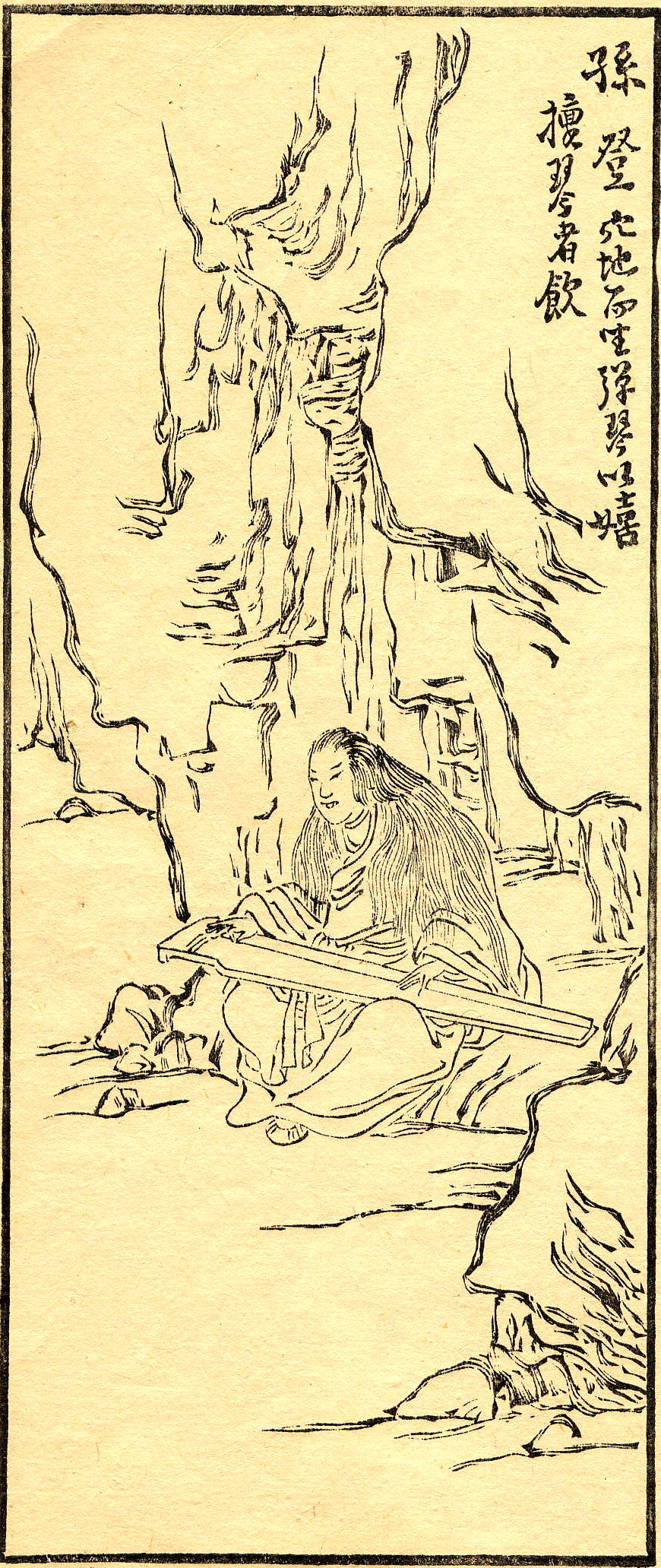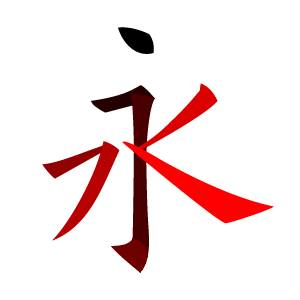|
Transcendental Whistling
''Chángxiào'' (Chinese: 長嘯; pinyin: chángxiào) or transcendental whistling was an ancient Daoist technique of long-drawn, resounding whistling that functioned as a qigong or transcendental exercise. A skillful whistler could supposedly summon animals, communicate with supernatural beings, and control weather phenomena. Transcendental whistling is a common theme in Chinese literature, for instance Chenggong Sui's (3rd century) ''Xiaofu'' 嘯賦 "Rhapsody on Whistling" and Ge Fei 's (1989) ''Hūshào'' 忽哨 "Whistling" short story. The most famous transcendental whistlers lived during the 3rd century, including the last master Sun Deng, and two of the eccentric Seven Sages of the Bamboo Grove, Ruan Ji and Ji Kang, all of whom were also talented zitherists. Terminology The Chinese language has two common words meaning "to whistle": ''xiào'' 嘯 or 啸 "whistle; howl; roar; wail" and ''shào'' 哨 "warble; chirp; whistle; sentry". Word usage of ''xiào'' 嘯 (first ... [...More Info...] [...Related Items...] OR: [Wikipedia] [Google] [Baidu] |
Sun Deng
Sun Deng (Wade–Giles: Sun Teng) is the name of: * Sun Deng (Xin dynasty) (died 26 AD), rebel leader *Sun Deng (Eastern Wu) Sun Deng (209 – May or June 241), courtesy name Zigao, was an imperial prince of the state of Eastern Wu during the Three Kingdoms period of China. He was the eldest son of Sun Quan, Eastern Wu's founding emperor, and was crown prince from 229 ... (209–241), crown prince * Sun Deng (recluse) (third century), Taoist recluse {{hndis ... [...More Info...] [...Related Items...] OR: [Wikipedia] [Google] [Baidu] |
Stroke (CJKV Character)
CJK strokes () are the calligraphic strokes needed to write the Chinese characters in regular script used in East Asian calligraphy. CJK strokes are the classified set of line patterns that may be arranged and combined to form Chinese characters (also known as Hanzi) in use in China, Japan, and Korea. Purpose The study and classification of CJK strokes is used for: #understanding Chinese calligraphy, Chinese character calligraphy – the correct method of writing, shape formation and stroke order required for character legibility; #understanding stroke changes according to the style that is in use; #defining stroke naming and counting conventions; #identifying fundamental components of Radical (Chinese characters), Han radicals; and #their use in computing. Formation When writing Han radicals, a single stroke includes all the motions necessary to produce a given part of a character before lifting the writing instrument from the writing surface; thus, a single stroke may ha ... [...More Info...] [...Related Items...] OR: [Wikipedia] [Google] [Baidu] |
Radical 85
Radical 85 or radical water () meaning "water" is a Kangxi radical; one of 35 of the 214 that are composed of 4 strokes. Its left-hand form, , is closely related to Radical 15, ''bīng'' (also known as 两点水 ''liǎngdiǎnshuǐ''), meaning "ice", from which it differs by the addition of just one stroke. In the ''Kangxi Dictionary'', there are 1,595 characters (out of 40,000) to be found under this radical. is also the 77th indexing component in the ''Table of Indexing Chinese Character Components'' predominantly adopted by Simplified Chinese dictionaries published in mainland China, with and being its associated indexing component. In the Chinese wuxing ("Five Phases"), 水 represents the element Water. In Taoist cosmology, 水 (Water) is the nature component of the bagua diagram ''kǎn''. Evolution File:水-oracle.svg, Oracle bone script character File:水-bronze.svg, Bronze script character File:水-bigseal.svg, Large seal script character File:水-seal.svg, Small ... [...More Info...] [...Related Items...] OR: [Wikipedia] [Google] [Baidu] |
Radical 140
Radical 140 or radical grass () meaning "grass" is one of 29 of the 214 Kangxi radicals that are composed of 6 strokes. It transforms into when appearing at the top of a character or component. In the ''Kangxi Dictionary'' and in modern standard Traditional Chinese as used in Taiwan, Hong Kong and Macau, (with two horizontal strokes) consists of four strokes, while in Simplified Chinese and modern Japanese, (with a continuous horizontal stroke) consists of three strokes. In the ''Kangxi Dictionary'' there are 1902 characters (out of 40,000) found under this radical, making it the most commonly used radical. , the upper component form of , is the 30th indexing component in the ''Table of Indexing Chinese Character Components'' predominantly adopted by Simplified Chinese dictionaries published in mainland China, while is listed as its associated indexing component. Evolution File:艸-seal.svg, Small seal script character Derived characters Variant forms This radical cha ... [...More Info...] [...Related Items...] OR: [Wikipedia] [Google] [Baidu] |
Radical 118
Radical 118 or radical bamboo () meaning "bamboo" is one of the 29 Kangxi radicals (214 radicals in total) composed of 6 strokes. The radical character usually appears at the top of characters and transforms into . In the ''Kangxi Dictionary'', there are 953 characters (out of 49,030) to be found under this radical. is also the 135th indexing component in the ''Table of Indexing Chinese Character Components'' predominantly adopted by Simplified Chinese dictionaries published in mainland China, with being its associated indexing component. Evolution File:竹-oracle.svg, Oracle bone script character File:竹-bronze.svg, Bronze script character File:竹-bigseal.svg, Large seal script character File:竹-seal.svg, Small seal script character Derived characters Literature * * External links Unihan Database - U+7AF9 {{Simplified Chinese radicals 118 135 135 may refer to: * 135 (number) * AD 135 * 135 BC * 135 film, better known as 35 mm film, is a format of photographic fi ... [...More Info...] [...Related Items...] OR: [Wikipedia] [Google] [Baidu] |
Onomatopoeic
Onomatopoeia is the process of creating a word that phonetically imitates, resembles, or suggests the sound that it describes. Such a word itself is also called an onomatopoeia. Common onomatopoeias include animal noises such as ''oink'', ''meow'' (or ''miaow''), ''roar'', and ''chirp''. Onomatopoeia can differ between languages: it conforms to some extent to the broader linguistic system; hence the sound of a clock may be expressed as ''tick tock'' in English, in Spanish and Italian (shown in the picture), in Mandarin, in Japanese, or in Hindi. The English term comes from the Ancient Greek compound ''onomatopoeia'', 'name-making', composed of ''onomato''- 'name' and -''poeia'' 'making'. Thus, words that imitate sounds can be said to be onomatopoeic or onomatopoetic. Uses In the case of a frog croaking, the spelling may vary because different frog species around the world make different sounds: Ancient Greek (only in Aristophanes' comic play ''The Frogs'') probably ... [...More Info...] [...Related Items...] OR: [Wikipedia] [Google] [Baidu] |
Chepang Language , the language of the Chepang people
{{dab ...
Chepang may refer to: *Chepang people, a group indigenous to the lands of Nepal *Chepang language Chepang may refer to: * Chepang people, a group indigenous to the lands of Nepal * Chepang language, the language of the Chepang people {{dab ... [...More Info...] [...Related Items...] OR: [Wikipedia] [Google] [Baidu] |
Proto-Tibeto-Burman Language
Proto-Tibeto-Burman (commonly abbreviated PTB) is the reconstructed ancestor of the Tibeto-Burman languages, that is, the Sino-Tibetan languages, except for Chinese. An initial reconstruction was produced by Paul K. Benedict and since refined by James Matisoff. Several other researchers argue that the Tibeto-Burman languages ''sans'' Chinese do not constitute a monophyletic group within Sino-Tibetan, and therefore that Proto-Tibeto-Burman was the same language as Proto-Sino-Tibetan. Issues Reconstruction is complicated by the immense diversity of the languages, many of which are poorly described, the lack of inflection in most of the languages, and millennia of intense contact with other Sino-Tibetan languages and languages of other families. Only a few subgroups, such as Lolo-Burmese, have been securely reconstructed. Benedict's method, which he dubbed "teleo-reconstruction", was to compare widely separated languages, with a particular emphasis on Classical Tibetan, Jingpho, ... [...More Info...] [...Related Items...] OR: [Wikipedia] [Google] [Baidu] |
Cognates
In historical linguistics, cognates or lexical cognates are sets of words in different languages that have been inherited in direct descent from an etymological ancestor in a common parent language. Because language change can have radical effects on both the sound and the meaning of a word, cognates may not be obvious, and often it takes rigorous study of historical sources and the application of the comparative method to establish whether lexemes are cognate or not. Cognates are distinguished from loanwords, where a word has been borrowed from another language. The term ''cognate'' derives from the Latin noun '' cognatus blood relative'. Characteristics Cognates need not have the same meaning, which may have changed as the languages developed independently. For example English '' starve'' and Dutch '' sterven'' 'to die' or German '' sterben'' 'to die' all descend from the same Proto-Germanic verb, '' *sterbaną'' 'to die'. Cognates also do not need to look or sound simila ... [...More Info...] [...Related Items...] OR: [Wikipedia] [Google] [Baidu] |
Sound Symbolism
In linguistics, sound symbolism is the resemblance between sound and meaning. It is a form of linguistic iconicity. For example, the English word ''ding'' may sound similar to the actual sound of a bell. Linguistic sound may be perceived as similar to not only sounds, but also to other sensory properties, such as size, vision, touch, or smell, or abstract domains, such as emotion or value judgment. Such correspondence between linguistic sound and meaning may significantly affect the form of spoken languages. History Plato and the Cratylus Dialogue In ''Cratylus'', Plato has Socrates commenting on the origins and correctness of various names and words. When Hermogenes asks if he can provide another hypothesis on how signs come into being (his own is simply 'convention'), Socrates initially suggests that they fit their referents in virtue of the sounds they are made of: However, faced by an overwhelming number of counterexamples given by Hermogenes, Socrates has to admit that " ... [...More Info...] [...Related Items...] OR: [Wikipedia] [Google] [Baidu] |
Old Chinese
Old Chinese, also called Archaic Chinese in older works, is the oldest attested stage of Chinese language, Chinese, and the ancestor of all modern varieties of Chinese. The earliest examples of Chinese are divinatory inscriptions on oracle bones from around 1250 BC, in the late Shang dynasty. Chinese bronze inscriptions, Bronze inscriptions became plentiful during the following Zhou dynasty. The latter part of the Zhou period saw a flowering of literature, including Four Books and Five Classics, classical works such as the ''Analects'', the ''Mencius (book), Mencius'', and the ''Zuo zhuan''. These works served as models for Literary Chinese (or Classical Chinese), which remained the written standard until the early twentieth century, thus preserving the vocabulary and grammar of late Old Chinese. Old Chinese was written with several early forms of Chinese characters, including Oracle bone script, Oracle Bone, Chinese bronze inscriptions, Bronze, and Seal scripts. Throughout ... [...More Info...] [...Related Items...] OR: [Wikipedia] [Google] [Baidu] |


